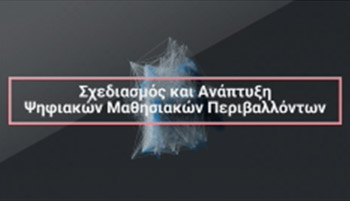| Semester: | 3rd | Course Tutors: | Γεωργούλη Κατερίνα, Καθηγήτρια | |
| Group: | 2 | |||
| Category: | Elective Courses | See the detailed Course Outline (pdf) | ||
| ECTS: | 7 | Presentation: |  |
Design and Development of Digital Learning Environments
COURSE CONTENT
- Unit 1: Blended Learning and Support Tools
1.1 E-Learning and Educational Technology
• The concept of blended learning, examples, challenges, and objectives
• The role of educational technology in blended learning
1.2 Tools for a Technology-Supported Classroom
• Blogs, Wikis, Podcasts
• Surveys with Google Forms
• Scratch, quizzes with ClassMarker
• Educational videos with VideoScribe, quiz integration with Edpuzzle
• Using MIT App Inventor and Blippar - Unit 2: Contemporary Learning Environments
2.1 Environments for Remote Synchronous Support
• Video conferencing: Skype, Zoom, Microsoft Teams
• Social networks
2.2 Environments for Massive Open Asynchronous Remote Teaching – MOOCs - Unit 3: Educational Software and Learning Environments
3.1 General Features of Knowledge Acquisition Software
• Learning environments
• Hypermedia/Multimedia
• Self-assessment/Exercises
• Simulations
• Educational games
• E-Examination environments
3.2 Open Hypermedia Learning Content Resources
• Resources like Photodentro and others - Unit 4: Stages of Educational Software Development
4.1 Development Stages (Analysis-Design-Implementation-Distribution)
4.2 Review of Design and Development Models
• Analysis
• Design
• Prototyping and Development
• Evaluation
• Software usage rights (copyrights) - Unit 5: Development and Design Tools for Multimedia Applications
5.1 Authoring Tools for Multimedia Applications
5.2 Online Multimedia Applications, Website Creation with HTML5, Hyperlink, and Hypermedia Enrichment - Unit 6: Designing and Creating a Multimedia Application with Modern Tools
6.1 Design and Creation of a Multimedia Application
• Integration of hypermedia and dynamic text
• Synthetic motion
• Drag-and-drop elements
• Quizzes, images, and videos
6.2 Linking, Integrating, and Embedding Interactive Content and Multimedia Applications in Existing Educational Environments, Platforms, or Websites - Unit 7: Summary and Application in a Practical Scenario
7.1 Presentation of Modern Tools (e.g., MIT App Inventor, Blippar) for Creating Multimedia Educational Environments
7.2 Applying Previous Units in a Model Environment in Collaboration with Students
The course aims to understand, apply, and leverage modern tools and technologies
for designing and developing digital learning environments.


